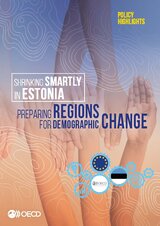Développement régional, urbain et rural

Shrinking Smartly in Estonia
Preparing Regions for Demographic Change
Many lower density regions in the OECD face shrinkage, with projections suggesting
that half of Europe will need to manage decline in remote regions by 2050. Half of
Estonia’s counties experienced population decline greater than 25% since 1991. Shrinkage
leads to problems including lower municipal revenues, ageing, and greater per capita
costs of service and infrastructure provision. Estonia is also the most carbon-intensive
economy in the OECD, and heavily utilises its forests and land. To tackle these challenges,
the report provides analyses in a number of policy areas to respond to demographic
change in a smart and sustainable manner. A policy framework that emphasises a spatially
oriented, coordinated approach for responding to shrinkage is developed. The report
provides policy recommendations to make land use more efficient and spatial planning
more coherent. It suggests ways to improve the transfer system and strengthen the
municipal revenue base while encouraging inter-municipal cooperation. It also discusses
education, the municipalities’ largest spending responsibility, providing recommendations
that adapt the school network to shrinkage while ensuring access to high-quality education
for all students.
Available from February 18, 2022
In series:OECD Rural Studiesview more titles
TABLE OF CONTENTS
| Foreword | |
| Abbreviations and acronyms | |
| Executive summary | |
| Assessment and recommendations | |
| Setting the scene | |
| Adapting land use and spatial planning to shrinkage in Estonia | |
| Financing local public services and infrastructure in Estonia: Challenges and ways forward | |
| The present and future provision of education in Estonia |
Powered by OECD iLibrary
